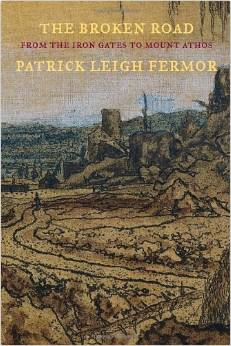 In December 1933, eighteen-year-old Patrick Leigh Fermor began a journey on foot from Holland to Istanbul. Last year I reviewed the two books that cover the first two legs of the journey, A Time of Gifts and Between the Woods and the Water, but had to wait until this third volume was published to finish the journey.
In December 1933, eighteen-year-old Patrick Leigh Fermor began a journey on foot from Holland to Istanbul. Last year I reviewed the two books that cover the first two legs of the journey, A Time of Gifts and Between the Woods and the Water, but had to wait until this third volume was published to finish the journey.
Unfortunately, Leigh Fermor never completed this book. He actually began writing it first, about ten years after his journey, but stalled. Many years later he wrote the other two books and finally returned to this one. The editors explain in the introduction that they had to piece bits of it together from the manuscript, one of his surviving diaries (others were lost), and other documents. They did a great job, for it only seems fragmentary for a few pages in the middle.
This travelogue picks up at the Iron Gates by the Danube in Rumania but almost immediately moves to Bulgaria. Leigh Fermor spends a great deal of the book traipsing around the Bulgarian countryside meeting colorful characters before abruptly deciding to go to Bucharest. As most of this section of the book is written from his memories of what happened because of his lost diaries, I can only say that his memory must have been remarkable. He writes in a vividly descriptive style, allowing you to imagine yourself along on his trip through a world that is long gone.
It is remarkable also that almost everywhere on this journey he meets with kindness and hospitality. Only one night as he miserably hobbled along in Bulgaria after his foot was rubbed all day by a boot nail were his requests for a ride on two different passing wagons met with demands for money. Since he was living on a pound a week, wired periodically by his parents, he chose to walk. That same night his appeal for shelter at one house met no response from inhabitants who were clearly home. But farther down the road some charcoal burners cheerfully took him in.
Only at all disappointing is his description, which is almost nonexistent, of Istanbul. (He persists in calling it Constantinople.) I can only suppose his visit was in some way spoiled, as it is clear from his comments on the way there that he had romantic notions of the East. A footnote repeats his remark that he never left Constantinople without a lightening of the heart.
Leigh Fermor’s book ends where his green diary picks up, with his travels all over Mount Athos, Greece’s Holy Mountain. There he visited one Eastern Orthodox monastery after another. This section is fascinating for its glimpses into this unusual mode of life. Fermor came to love Greece so much that he lived there much of his life, and this was his first experience of it.
I actually found this book easier to read than the other two more polished efforts, as enjoyable as they are. I think it is because it was written by his younger self. For although he was kicked out of prep school before this journey and never returned to a formal education, he plainly was frightfully well read and knowledgeable and constantly lost me in the earlier books with classical or poetic allusions that I was too lazy to look up.
Apparently Leigh Fermor, who was clearly adventurous, went on to live an exciting life. I have a biography of him waiting for me in my pile.
If you have read my reviews of Leigh Fermor’s other books, you may have noticed a discrepancy. In those I say he was nineteen at the beginning of his adventures. Well, that’s what he said, but since he celebrated his 20th birthday at a monastery in February 1935 and started his journey in December more than a year before, even I can do the math. I did notice him referring to himself as twenty before he actually turned it, so that’s probably what happened in the earlier books.

Sounds like a fascinating journey!
I think it’s really interesting. That Europe is mostly gone. The part in Germany with the incipient Nazism is interesting, too.